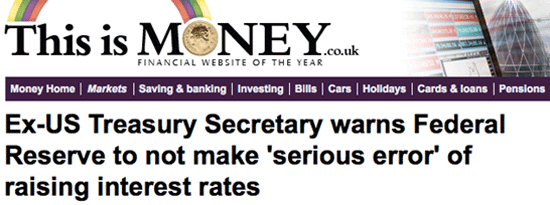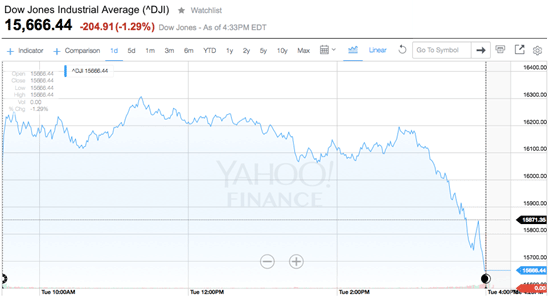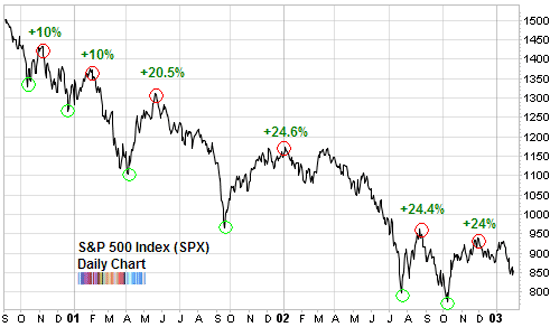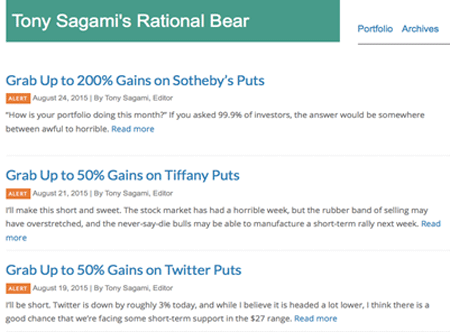Are you worried about the stock market? You should be; at least according to your local Starbucks barista.
Starbucks CEO Howard Schultz told his 190,000 employees in his daily “Message from Howard” email communication: “Today’s financial market volatility, combined with great political uncertainty both at home and abroad, will undoubtedly have an effect on consumer confidence and … our customers are likely to experience an increased level of anxiety and concern. Let’s be very sensitive to the pressures our customers may be feeling.”
You can’t make this stuff up!
Hey, maybe I shouldn’t be too harsh on Mr. Schultz, because the stock market is in a lot of trouble… and not for the reasons the mass media and Wall Street experts are telling you.
The know-it-alls on CNBC are pointing their fingers at the Chinese stock market meltdown as the reason for our stock market turmoil, but that is just the catalyst… not the root problem.
The source of the meltdown is deeper, more problematic, and more painful. What I’m talking about is that the Federal Reserve—from Greenspan to Bernanke, to Yellen—thought they possessed Wizard of Oz powers to fix whatever ails the economy with their menu of monetary tools.
In 2000, the Fed thought it could solve the bursting of the dot-com bubble with massive interest rate cuts and repeated that playbook again for the 2008-09 Financial Crisis.
And when they ran out of room by cutting interest rates to zero, they trotted out Operation Twist and QE 1, 2, and 3.

Those three rounds of QE added about $3.7 trillion to the Federal Reserve’s balance sheet since 2008, which now totals a mind-boggling $4.5 trillion.
The problem is not China; the problem is Janet Yellen and her Federal Reserve buddies.

The Fed—beginning with the original monetary Mr. Magoo of Alan Greenspan—created a bubble, then rolled out more of the same to deal with the bursting of the bubble, and like the shampoo bottle says: Rinse, Lather, Repeat.
Zero interest rates plus QE1, QE2, and QE3 created a massive misallocation of capital that has affected everything from home supply, ocean-going freighters, the US dollar, and wages, and pushed stock prices to a bigger-than-ever bubble.

The recent weakness is the painful process of deflating that bubble, but the Federal Reserve refuses to learn from its mistakes. It won’t be long until we hear about QE4 and/or a delay to the overpromised interest rate liftoff.
Former US Treasury Secretary Larry Summers had this to say yesterday: “A reasonable assessment of current conditions suggests that raising rates in the near future would be a serious error that would threaten all three of the Fed’s major objectives; price stability, full employment and financial stability.”
Honestly, I don’t know what the Federal Reserve will do next. Heck, I bet they don’t know what to do either… but they will do something.
Central bankers are arrogant know-it-alls who think they can fix the world’s financial problems with a couple of pulls of a monetary lever.
So pull they will.
And so the stock market damage will continue, albeit with some powerful up moves along the way.
Bulls, whether in a Spanish bull-fighting arena or roaming the floor of the NYSE, are a tough animal to kill. They won’t surrender until they make a few more desperate attempts to push the market higher.
Look at what happened last Tuesday after the 588-point Monday meltdown. The Dow Jones Industrial Average shot up by as much as 441 points before ending the day with a 204-point loss.

My point is that you’re going to see a lot of powerful up moves in the coming months… but I’m telling you, these are nothing more than bear market traps to lure you into buying at the wrong time.
The stock market is falling into a bear market, and that means big swings both up and down, similar to 2000–2003.

The Federal Reserve, along with the rest of the world’s central bankers, has puffed stock valuations into an epic bubble, and the stock market has a long, long ways yet to fall… just not in a straight line.
That’s heart attack material for both buy-hold-and-pray and buy-the-dip investors, but it is a goldmine if you adapt your strategy.

Instead of buying the dip, the right strategy going forward is SELL THE RIP.
When the stock market gives you a big rally, the right move will be to sell into strength.
And if you have some risk capital, that will be the time to load up on inverse ETFs and put options, like my Rational Bear subscribers did in July.
The biggest short-selling opportunity of our lifetimes is knocking on your door.

Tony Sagami
30-year market expert Tony Sagami leads the Yield Shark and Rational Bear advisories at Mauldin Economics. To learn more about Yield Shark and how it helps you maximize dividend income, click here. To learn more about Rational Bear and how you can use it to benefit from falling stocks and sectors, click here.

